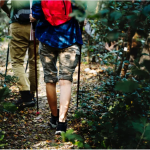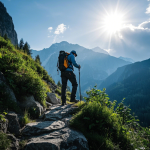Before setting off, it is extremely important to prepare the right equipment. Here is a list of basic outdoor equipment suitable for hiking activities. You can choose the right equipment according to your actual needs.

Wearing items
Clothing
Storm jackets and pants:
This is a must-have for outdoor activities. It has many advantages such as windproof, waterproof, breathable and wear-resistant, which can effectively protect you from the bad weather during hiking.
Fleece jackets:
It mainly plays the role of windproof and warmth. When the weather is slightly cooler or the temperature difference between morning and evening is large, it can keep you warm and comfortable.
Sweat-wicking underwear:
After outdoor exercise, it can help the body quickly excrete sweat, keep the body dry, and prevent you from feeling uncomfortable due to sweat accumulation.
Quick-drying clothes and pants:
Especially suitable for summer travel. It is best to choose a style with trouser legs and sleeves that can be detached, which is convenient for adjusting the wearing state according to the actual situation. It also dries quickly and can cope with changeable weather and sweating.
Other personal clothing:
Like disposable underwear, sweat shirts, T-shirts, etc., you can prepare an appropriate amount according to your personal habits and the number of days of the trip, so that you can change them in time during the hike to keep your body clean.
Shoes and socks
Hiking shoes:
They are highly adaptable, very wear-resistant, and waterproof. It is recommended to choose mid-high top styles, which can better protect the ankles and avoid injuries when walking on rugged mountain roads.
Lightweight outdoor sports casual shoes:
Suitable for short-distance hiking activities in the suburbs, or change them while driving, so that the feet can relax properly.
Sweat-wicking socks:
They have a good sweat-wicking effect, can wick away foot sweat in time, and can also play a certain role in preventing frostbite in winter, so that the feet are always in a more comfortable state.
Ordinary sports socks:
Choose cotton and comfortable ones, which can be used as daily replacements.
Hats, gloves, glasses, headscarves
Sun hats:
Whether they are round-rimmed or baseball cap-style, as long as they can block the sun, they can help you avoid direct sunlight during hiking and protect your head and facial skin.
Thin gloves:
They are convenient for hand movements, such as when you want to take photos during hiking, there will not be too many obstacles, and they can also provide certain protection.
Glasses:
It is best to choose sports ones, whose main function is to block the sun and prevent ultraviolet rays, so that you can see the surrounding environment more clearly and comfortably outdoors.
Headscarf:
It can be used to wipe sweat, as a scarf, to keep warm, and as a decoration when taking photos, adding a bit of outdoor fashion.
Equipment and supplies
Backpacks
Large backpack:
If you are going on a long-distance hike or a hike that requires carrying camping equipment, a large backpack is a must. Choose one that is comfortable to carry and can bear a certain weight. The capacity generally ranges from 45 to 80L, which is convenient for carrying various items.
Small backpack:
Suitable for short-distance hiking, or as a backup bag for long-distance hiking. It has a certain carrying function and a capacity between 15 and 30L, which is convenient for carrying some commonly used small items.
Lighting
Headlamp:
During hiking, especially when you may have to rush in the morning or evening or enter a dimly lit area, a headlamp can free up your hands and facilitate movement. It is a very practical lighting tool.
Flashlight:
It can be used as a backup lighting device to prevent emergencies such as headlamp failure, ensuring that you always have a light source available.
Water equipment
Outdoor kettle:
It can effectively prevent corrosion, and the appearance is diverse and cool. It is convenient to carry water and meet the drinking water needs during hiking.
Water bag:
It is more useful in long-term hiking activities such as outdoor crossing. It can easily replenish water and does not take up too much space.
Communication
Mobile phone:
It is the most commonly used contact method, but the signal may not be very good in some areas in the wild, so it is best to tell others your approximate itinerary before departure so that you can contact them in time when something happens.
Interphone:
If it is a team hiking activity, the intercom is very useful, which can facilitate the communication between the front and rear team members to ensure the safety and coordination of the entire team.
Survival whistle:
Easy to carry. In case of emergency, such as getting separated from teammates or needing help, it can be used as an effective team contact method to transmit information through specific whistle signals.
Others
Hiking pole:
Proper use of hiking poles can save about 20% of physical strength. It can also be used as a monopod when needed to help you maintain balance and reduce leg pressure during hiking.
Map:
Whether it is a long-distance or short-distance hike, maps are essential tools. Before setting off, you should be familiar with the routes, landmarks and other information on the map so that you can accurately identify the direction during the journey and avoid getting lost.
Compass:
It is also an important tool for identifying directions in the wild. In case you get lost or encounter a poor signal and cannot use electronic equipment to locate, it can help you find the right direction and continue to move forward.
Personal hygiene products:
Including toothbrushes, soap, towels, toothpaste, toilet paper, etc. Prepare an appropriate amount according to the number of days of hiking and personal habits to ensure personal hygiene and keep yourself in good condition outdoors.
Medicines:
Carry common medicines such as cold medicine, anti-inflammatory medicine, sunscreen, Band-Aids, etc. to deal with possible physical discomfort, such as colds, abrasions, sunburns, etc., to ensure health and safety during hiking.
Spare food:
Foods such as compressed biscuits, chocolate, beef jerky, etc. are high in energy and easy to carry and store. When you feel hungry during hiking or encounter special circumstances and cannot replenish food in time, you can replenish energy in time.

